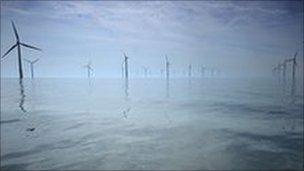European nations agree on offshore North Sea electric grid
- Published

European legislators are placing a lot of hope on off shore wind farms
Ministers from 10 European countries bordering the North Sea have agreed the construction of a new offshore electricity grid.
The grid will link countries across Europe and make it much easier for member states to trade energy.
It will also simplify the exploitation of the 140 Gigawatt offshore windfarm currently being planned in the North Sea.
Analysts say Europe needs offshore wind farms to meet emissions targets.
The Memorandum of Understanding was signed by the governments of the UK, Ireland, Belgium, Denmark, France, Germany, Luxembourg, the Netherlands, Norway and Sweden.
The new grid would be used to connect European grids to a large offshore windfarm currently in planning for the North Sea. The project is part of a concerted effort by the European Union to live up to its emissions targets and integrate the energy infrastructure.
One such cooperation is already in place. Norway and the Netherlands use so-called "high-voltage direct-current" links to pump energy back and forth between the two countries.
Another project currently under consideration is Desertec. This proposal, launched by a German consortium is aimed at putting a large number of solar energy modules into North Africa. These are then connected to European electricity grids.
The North Sea grid is a highly ambitious project but could prove an important boost to countries whose location gives them an excess of solar or wind energy.